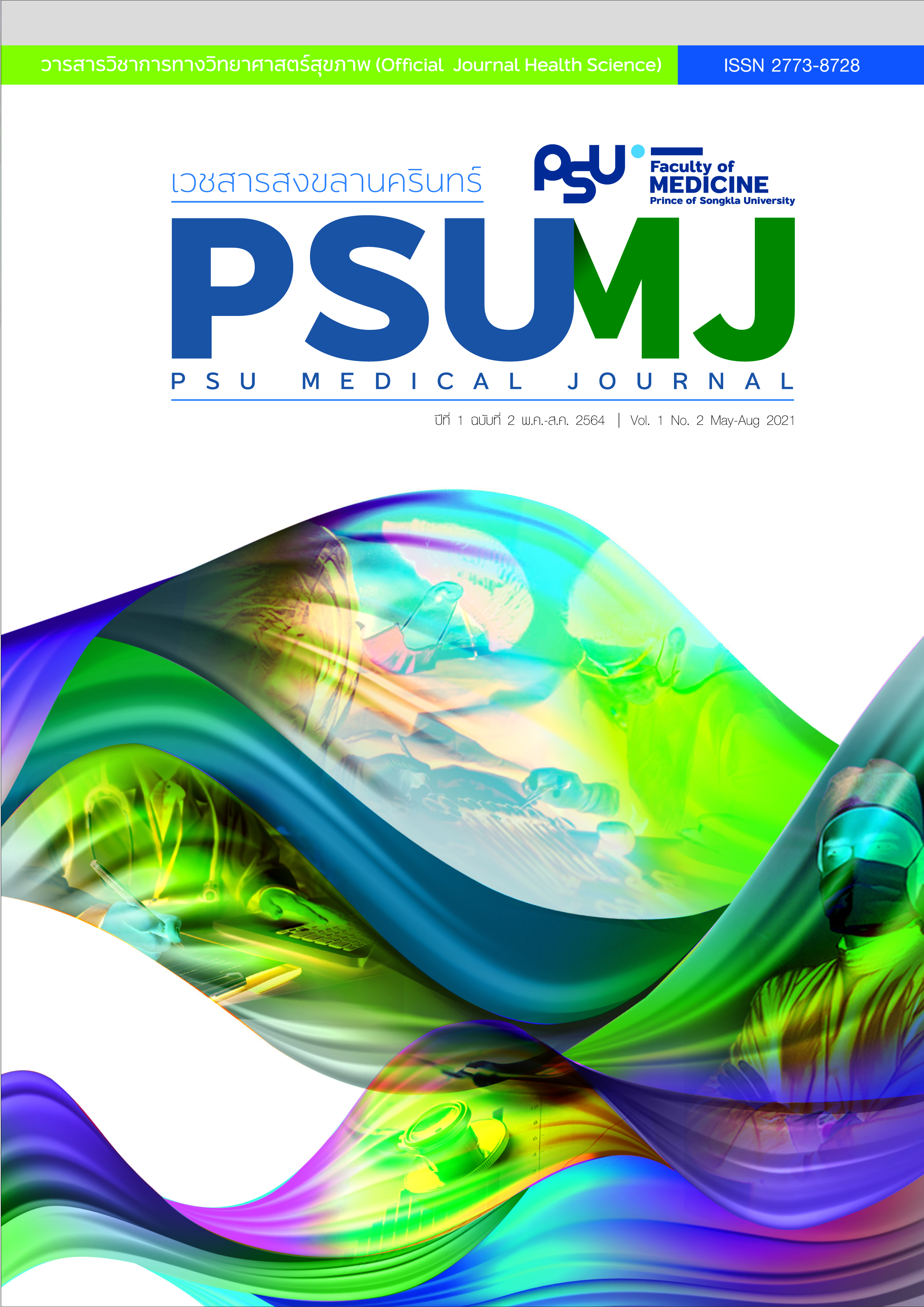Finite Element Approach Towards Selection of Appropriate Materials to Redistribute Peak Plantar Pressure in Diabetic Foot with Neuropathy
Selecting Appropriate Materials for Diabetic Foot
DOI:
https://doi.org/10.31584/psumj.2021247166Keywords:
custom made insole, diabetic foot, finite element analysis, insole materials, peak plantar pressureAbstract
Objective: The aim of this study was to assess the effect of customized insole (CMI) variations on plantar pressure in diabetic foot with neuropathy, using finite element analysis (FEA).
Material and Methods: A three-dimensional foot model was constructed using FEA to study the peak contact pressure between the foot and the CMI. Nora® Lunalastike, Ethylene Vinyl Acetate (EVA), Amfit® and TPU were chosen for insole materials; and from these eight CMI models were created. The top surface of the tibia and fibula were fixed, and a displacement of 3 mm was exerted from the ground along with upwards Achilles tendon force.
Results: The peak contact pressure contour showed that a softer material, CMI-A (E = 1.04 MPa), resulted in a better reduction of peak contact pressure compared to a stiffer material; CMI-D (E = 11 MPa). In addition, it was shown that the use of a single material to fabricate the CMI resulted in higher peak contact pressure; with the exception of CMI-A, in comparison to a dual-layer material of CMI-E and CMI-F. Using FEA, can effectively enhance the insole material selection process, without need of a trial and error practice in a clinical setting.
Conclusion: The use of dual materials to fabricate CMIs, with the softer material as a top layer, is beneficial compared to a stiffer top layer material in the reduction of peak plantar pressure for diabetic foot with neuropathy.
References
Moxey PW, Gogalniceanu P, Hinchliffe RJ, Loftus IM, Jones KJ, Thompson MM, et al. Lower extremity ampu tations--a review of global variability in incidence. Diabet Med 2011;28:1144-53.
Bartus CL, Margolis DJ. Reducing the incidence of foot ulceration and amputation in diabetes. Curr Diab Rep 2004; 4:413-8.
Armstrong DG, Boulton AJM, Bus SA. Diabetic Foot Ulcersand Their Recurrence. New Engl J Med 2017;376:2367-75.
Grimm A, Kastenbauer T, Sauseng S, Sokol G, Irsigler K. Progression and distribution of plantar pressure in Type 2 diabetic patients. Diabetes Nutr Metab 2004;17:108-13.
Boulton AJ, Kirsner RS, Vileikyte L. Clinical practice. Neuropathic diabetic foot ulcers. N Engl J Med 2004;351:48-55.
Boulton AJ, Vileikyte L, Ragnarson-Tennvall G, Apelqvist J The global burden of diabetic foot disease. Lancet 2005;366: 1719-24.
Cavanagh PR. Therapeutic footwear for people with diabetes. Diabetes Metab Res Rev 2004;20(Suppl1):S51-5.
Bus SA, Ulbrecht JS, Cavanagh PR. Pressure relief and load redistribution by custom-made insoles in diabetic patients with neuropathy and foot deformity. Clin Biomech (Bristol Avon) 2004;19:629-38.
Praet SF, Louwerens JW. The influence of shoe design on plantar pressures in neuropathic feet. Diabetes Care 2003; 26:441-5.
Gerrard JM, Bonanno DR, Whittaker GA, Landorf KB. Effect of different orthotic materials on plantar pressures: a systematic review. J Foot Ankle Res 2020;13:35.
Nouman M, Dissaneewate T, Leelasamran W, Chatpun S. The insole materials influence the plantar pressure distribu tions in diabetic foot with neuropathy during different walking activities. Gait Posture 2019;74:154-61.
Chatzistergos P, Gatt A, Formosa C, Farrugia K, Chockalingam N. Optimised cushioning in diabetic footwear can significantly enhance their capacity to reduce plantar pressure. Gait Posture 2020;79.
Ahmed S, Barwick A, Butterworth P, Nancarrow S. Footwear and insole design features that reduce neuropathic plantar forefoot ulcer risk in people with diabetes: a systematic literature review. J Foot Ankle Res 2020;13:30.
Turpin KM, De Vincenzo A, Apps AM, Cooney T, MacKenzie MD, Chang R, et al. Biomechanical and clinical outcomes with shock-absorbing insoles in patients with knee osteoar thritis: immediate effects and changes after 1 month of wear. Arch Phys Med Rehabil 2012;93:503-8.
Sun X, Lam WK, Zhang X, Wang J, Fu W. Systematic review of the role of footwear constructions in running biomechanics: Implications for running-related injury and performance. J Sports Sci Med 2020;19:20-37.
Wang L, Hong Y, Li JX. Durability of running shoes with ethylene vinyl acetate or polyurethane midsoles. J Sports Sci 2012;30:1787-92.
Lo WT, Wong DP, Yick KL, Ng SP, Yip J. Effects of custommade textile insoles on plantar pressure distribution and lower limb EMG activity during turning. J Foot Ankle Res 2016;9:22.
Wang Y, Wong DW, Zhang M. Computational models of the foot and ankle for pathomechanics and clinical applications: a review. Ann Biomed Eng 2016;44:213-21.
Luo GM, Houston VL, Garbarini MA, Beattie AC, Thongpop C. Finite element analysis of heel pad with insoles. J Biomech 2011;44:1559-65.
Ghassemi A, Mossayebi AR, Jamshidi N, Naemi R, Karimi MT. Manufacturing and finite element assessment of a novel pressure reducing insole for diabetic neuropathic patients. Australas Phys Eng Sci Med 2015;38:63-70.
Morton DJ. Evolution of the human foot. Am J Phys Anthropol 1922;5:305-36.
Cheung JT, Zhang M. A 3-dimensional finite element model of the human foot and ankle for insole design. Arch Phys Med Rehabil 2005;86:353-8.
Su S, Mo Z, Guo J, Fan Y. The effect of arch height and material hardness of personalized insole on correction and tissues of flatfoot. J Healthc Eng 2017;2017:8614341.
Zhang M, Mak AF. In vivo friction properties of human skin. Prosthet Orthot Int 1999;23:135-41.
Tang L, Wang L, Bao WN, Zhu SY, Li DC, Zhao NX, et al. Functional gradient structural design of customized diabetic insoles. J Mech Behav Biomed 2019;94:279-87.
Mates M. Atlas of anatomy: general anatomy and musculoskeletal system. Occup Ther Health Care 2008;22:76-7.
Dian W, Ping C. Finite element analysis of the expression of plantar pressure distribution in the injury of the lateral Ligament of the Ankle. Nano Biomed Eng 2019;11:290-6.
Hsu YC, Gung YW, Shih SL, Feng CK, Wei SH, Yu CH, et al. Using an optimization approach to design an insole for lowering plantar fascia stress--a finite element study. Ann Biomed Eng 2008;36:1345-52.
Nouman M, Leelasamran W, Chatpun S. Effectiveness of total contact orthosis for plantar pressure redistribution in neuropathic diabetic patients during different walking activities. Foot Ankle Int 2017;38:901-8.
Wang Y, Wong DW, Tan Q, Li Z, Zhang M. Total ankle arthroplasty and ankle arthrodesis affect the biomechanics of the inner foot differently. Sci Rep 2019;9:13334.
Armstrong DG, Boulton AJM, Bus SA. Diabetic foot ulcers and their recurrence. New Engl J of Med 2017;376:2367-75.
Guiotto A, Sawacha Z, Guarneri G, Avogaro A, Cobelli C. 3D finite element model of the diabetic neuropathic foot: a gait analysis driven approach. J Biomech 2014;47:3064-71.
Goske S, Erdemir A, Petre M, Budhabhatti S, Cavanagh PR. Reduction of plantar heel pressures: Insole design using finite element analysis. J Biomech 2006;39:2363-70.
Albert S, Rinoie C. Effect of custom orthotics on plantar pressure distribution in the pronated diabetic foot. J Foot Ankle Surg 1994;33:598-604.
Kitaoka HB, Luo ZP, Kura H, An KN. Effect of foot orthoses on 3-dimensional kinematics of flatfoot: a cadaveric study. Arch Phys Med Rehabil 2002;83:876-9.
Cheung JT, Zhang M. Parametric design of pressurerelieving foot orthosis using statistics-based finite element method. Med Eng Phys 2008;30:269-77.
Lemmon D, Shiang TY, Hashmi A, Ulbrecht JS, Cavanagh PR. The effect of insoles in therapeutic footwear--a finite element approach. J Biomech 1997;30:615-20.
Hellstrand Tang U, Zügner R, Lisovskaja V, Karlsson J, Hagberg K, Tranberg R. Comparison of plantar pressure in three types of insole given to patients with diabetes at risk of developing foot ulcers–A two-year, randomized trial. J Clin Transl Endocrinol 2014;1:121-32.
Sarikhani A, Motalebizadeh A, Asiaei S, Kamali Doost Azad B. Studying maximum plantar stress per insole design using foot CT-scan images of hyperelastic soft ti sues. Appl Bonics Biomech 2016;2016:8985690.
Davia-Aracil M, Hinojo-Pérez JJ, Jimeno-Morenilla A, Mora- Mora H. 3D printing of functional anatomical insoles. Comput Ind 2018;95:38-53.
Guldemond NA, Leffers P, Schaper NC, Sanders AP, Nieman F, Willems P, et al. The effects of insole configurations on fore foot plantar pressure and walking convenience in diabetic patients with neuropathic feet. Clin Biomech (Bristol, Avon) 2007; 22:81-7.
Fauli AC, Andres CL, Rosas NP, Fernandez MJ, Parreno EM, Barcelo CO. Physical evaluation of insole materials used to treat the diabetic foot. J Am Podiat Med Assn 2008;98:229-38.
Brilakis E, Kaselouris E, Xypnitos F, Provatidis CG, Efstathopoulos N. Effects of foot posture on fifth metatarsal fracture healing: a fi nite elementstudy. J Foot Ankle Surg 2012;51:720-8.
Chen WP, Ju CW, Tang FT. Effects of total contact insoles on the plantar stress redistribution: a finite element analysis. Clin Biomech (Bristol, Avon) 2003;18:S17-24.
Wright DG, Rennels DC. A study of the elastic properties of plantar fascia. J Bone Joint Surg Am 1964;46:482-92.
Lo WT, Yick K, Ng Z, Yip J. Numerical simulation of orthotic insole deformation for diabetic foot. J Fiber Bioeng Inform 2015;8:401-11.
Lewis G. Finite element analysis of a model of a therapeutic shoe: effect of material selection for the outsole. Biomed Mater Eng 2003;13:75-81.
Frick A, Rochman A. Characterization of TPU-elastomers by thermal analysis (DSC). Polym Test 2004;23:413-7.








